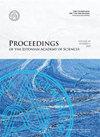Efficient capital management using an internal model: a case of non-life insurance
IF 0.7
4区 综合性期刊
Q3 MULTIDISCIPLINARY SCIENCES
引用次数: 1
Abstract
. The main goal of insurance company management is to increase shareholders’ value and implement a strategy that promotes sustainable growth of the company. Well-known possible measures intended to achieve that goal are as follows: share price, economic value, market capitalisation, gross premiums earned and solvency ratio. These measures include efficient capital management as capital expenses could be a major cost position depending on risk appetite and the extent of capital needed to support it. This research focuses on non-life insurers for reserve risk modelling. In the current study, a more accurate risk quantification model has been developed than the standard model provided by the EU regulator under the Solvency II framework. The proposed model provides capital cost gains as well. A case study based on non-life real data set with underwriting in the Baltic countries is discussed with inclusion of pandemic trends that had an impact on economies and customer behaviours. The study considers different non-life reserve distributions for each insurance business line, risk aggregation and the way of choosing the most appropriate type of copula model for non-life reserve risk. Adequate capital is calculated by applying value at risk at 99.5%, which is mandatory in the EU market. The study considers which selected tests have to be implemented in order to choose the most appropriate copula model for reserve risk. at risk.利用内部模型进行有效资本管理:以非寿险为例
. 保险公司管理的主要目标是提高股东价值,实施促进公司可持续发展的战略。为实现这一目标,人们所熟知的可能衡量指标如下:股价、经济价值、市值、已赚毛保费和偿付能力比率。这些措施包括有效的资本管理,因为资本支出可能是主要的成本,这取决于风险偏好和支持它所需的资本程度。本研究主要针对非寿险保险公司的准备金风险建模。在当前的研究中,开发了一个比欧盟监管机构在偿付能力II框架下提供的标准模型更准确的风险量化模型。所提出的模型也提供了资本成本收益。本文讨论了一个基于波罗的海国家承保的非寿险真实数据集的案例研究,其中包括对经济和客户行为产生影响的大流行病趋势。研究考虑了各险种非寿险准备金的不同分布、风险聚集以及选择最适合非寿险准备金风险类型的联结模型的方法。充足的资本是通过应用99.5%的风险价值来计算的,这在欧盟市场是强制性的。为了选择最适合储备风险的联结模型,研究了必须实施哪些选择测试。处于危险之中。
本文章由计算机程序翻译,如有差异,请以英文原文为准。
求助全文
约1分钟内获得全文
求助全文
来源期刊

Proceedings of the Estonian Academy of Sciences
综合性期刊-综合性期刊
CiteScore
1.80
自引率
22.20%
发文量
24
审稿时长
>12 weeks
期刊介绍:
The Proceedings of the Estonian Academy of Sciences is an international scientific open access journal published by the Estonian Academy of Sciences in collaboration with the University of Tartu, Tallinn University of Technology, Tallinn University, and the Estonian University of Life Sciences.
The journal publishes primary research and review papers in the English language. All articles are provided with short Estonian summaries.
All papers to be published in the journal are peer reviewed internationally.
The journal is open to word-wide scientific community for publications in all fields of science represented at the Estonian Academy of Sciences and having certain connection with our part of the world, North Europe and the Baltic area in particular.
 求助内容:
求助内容: 应助结果提醒方式:
应助结果提醒方式:


